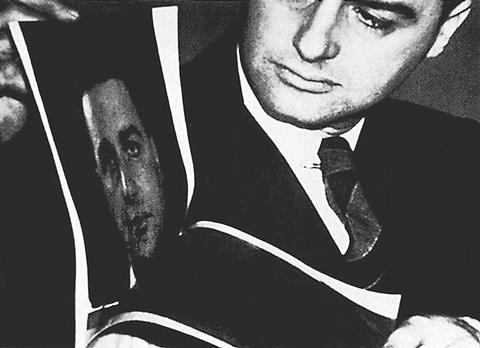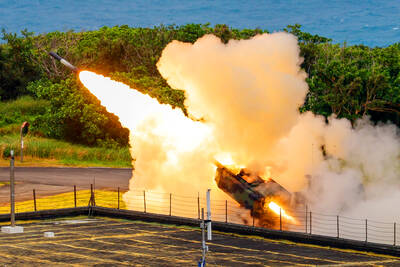The Polaroid Corp, once one of US industry's technological lights, filed for Chapter 11 bankruptcy protection on Friday. Most experts predict that Polaroid will never emerge, but will use the court's protection to set up a sale of its assets.
The news did not shock Wall Street, where analysts have watched the company's stock sink and debts soar as digital cameras hurt Polaroid's core instant photography business. But, it elicited a wave of sadness nonetheless.
"It just didn't have to come to this," said Ulysses Yannas, an analyst with Buckman, Buckman & Reid.

PHOTO: NY TIMES
When Edwin Land and George Wheelwright formed Polaroid in 1937, its future seemed ensured. Land was a scientist whose ideas for a lens that could polarize light -- that is, make light rays move in parallel -- formed the technological underpinnings not only of instant photography, but of glare-free sunglasses and goggles that World War II pilots used to spot submerged submarines. Wheelwright was a consummate salesman who built the business around the products.
Scientists respected the company for its devotion to research; investors respected it for the popularity of its products. Indeed, Polaroid was one of the Nifty 50, the big companies that in the 1960s were seen as the bellwethers of the US economy.
But at its heart, Polaroid was always a scientific house. And appropriately, it was brought down by the cold light of numbers.
By Friday, Polaroid was backed against a financial wall. Its stock, which approached US$50 in early 1998, was selling for US$0.28 when the New York Stock Exchange halted trading Wednesday. In its filing, the company listed US$1.81 billion in assets and US$948.4 million in debts. It has US$360 million in bank debt falling due on Nov. 15, and owes its bondholders about US$575 million.
"I never thought I could lose as much on a bond of a well known company as people lost on Internet start-ups," said Don Gonsalves, a bondholder who said he had lost 81.5 percent of his investment in two years. "The alternative that would result in the biggest payoff for all creditors would be for Polaroid to be completely liquidated."
Gary DiCamillo, Polaroid's chief executive since 1995, declined to be interviewed, but the company issued a statement saying that it had lined up US$50 million in financing, and intended to cut more jobs and accelerate efforts to sell assets. The company, which is based in Cambridge, Massachusetts, has also eliminated insurance benefits for retirees, and has stopped severance payments to employees who recently left. Polaroid subsidiaries outside the US are not part of the bankruptcy filing.
How did things go wrong so fast?
They didn't. Polaroid has been deep in debt since 1988, when it bought back shares, created an employee stock ownership plan and issued preferred stock, all to fight off a takeover by Shamrock Holdings, an investor group headed by Walt Disney's nephew Roy Disney.
"They issued a lot of bonds and borrowed a lot of money, and that's put them in the hole they're in today," said Edward Lee, a photography analyst at Lyra Research.
Polaroid made strategic mistakes in the early 1990s, too. Analysts say the company never responded properly after digital technologies began eating into every photography company's film sales.
It did not go into the booming home printer business. Instead it invested heavily in Helios, a so-called dry film technology used for medical imaging that had myriad problems. By the time Polaroid got the kinks and costs out of Helios, Kodak had cornered the market with Imation, a dry-film technology it had bought from 3M. Polaroid has abandoned that business.
"They should have gotten into batteries or other cash-flow-predictable products that are sold in the distribution channels they already used," suggested Vincent Muscolino, a manager of the David Babson Co's DLB Technology Fund, which is bullish on Eastman Kodak but has avoided Polaroid stock.
Polaroid also banked heavily on emerging markets, figuring -- correctly at first -- that they lacked an infrastructure for processing film and would favor instant photography.
Once Kodak, Fuji and others started developing film there, Polaroid lost the edge. Moreover, Polaroid was soon trounced by currency translation and slowing economies overseas.
On the home front, mass-market retailers like Wal-Mart cut back on inventories, including their purchases of Polaroid films. Polaroid's once-thriving commercial market faltered as insurance adjusters and others defected to digital cameras.
Unit sales have been high for Polaroid's newer consumer products, like the I-Zone, a cheap camera that makes sticker-sized pictures, and the JoyCam, a less expensive version of Polaroid's older Captiva camera.
But that is largely a result of huge rebates. And research shows that JoyCam and I-Zone owners use far fewer rolls of film each year than users of older instant cameras.
Meanwhile, Polaroid's costs were huge. Yannas of Buckman noted that while Polaroid's sales tripled to US$2.1 billion in 1998 from US$750 million in 1972, its sales staff grew more than fivefold, to 800 people from 140. The back office workers outnumbered the salespeople two to one. And unproductive salespeople were paid as much as stellar ones.
"The whole system was bloated with hangers-on," Yannas said.
Many fault Judith Boynton, who was Polaroid's chief financial officer until January, when she resigned.
Boynton, now chief financial officer for Royal Dutch-Shell in London, declined to be interviewed.
Boynton's performance clearly pleased the board, though. They promoted her to executive vice president two years ago, and made her the boss of many seasoned operating people.
Quite a few, including Brian Poggi, senior vice president for North America, and Clifford Hall, director of new product development who had been the mastermind behind the I-Zone, soon left.
Belatedly, Polaroid has tried to get costs down and cash flow up. It has already slashed its work force by about a quarter this year and has more cuts planned.
It also has sold some real estate, though a huge tax bite on depreciated property ate up much of the proceeds.
Polaroid's parts are now clearly worth more than the whole. There are millions of Polaroid cameras in use, which means a continuing demand for instant film.
The worldwide emphasis on security after the Sept. 11 terrorist attacks could make Polaroid's picture ID unit a tasty morsel to snap up.
Other camera companies -- Olympus and Canon are often mentioned -- might covet Polaroid's distribution network.
Telecommunications and printer companies may be lured by two new Polaroid technologies: Onyx, which captures wireless transmissions of images and converts them into black-and-white prints, and Opal, a new color printing method. Both use processes that dispense with toners and inks, and analysts give both high marks for cost and quality of prints.
Still, analysts say that Polaroid banked too much on them, as it did on Helios, I-Zone and JoyCam.
"There was always this next great product that will save the company," said Gibboney Huske of Credit Suisse First Boston.
"It was a vicious cycle of constantly putting all the eggs in one basket."
The phases of Polaroid
1937: Edwin H. Land founds Polaroid and develops products including day glasses and a polarizing desk lamp, 11 years after dropping out of Harvard University after his freshman year to study light polarization.
1947: Land introduces instant imaging at the Optical Society of America meeting in New York. A year later, the company introduces its first instant camera and film in Boston. The camera retails for US$89.50.
1963: Polaroid introduces instant color film and Model 100 folding pack camera, the first to use transistorized electronics to manage shutter speed for timing.
1972: Company introduces the SX-70, the first Polaroid camera that ejects a print from the camera, which then develops when exposed to light.
1983: Polaroid boasts 13,402 employees, US$1.3 billion in sales, and more than 1,000 patents. The company introduces the Polaroid Palette, a computer image recorder, and begins selling blank videocassette tapes.
1991: Land dies at age 81. The company produces its 1 billionth pack of instant film and is paid US$925 million by Eastman-Kodak to settle a patent infringement lawsuit.
1995: Gary DiCamillo is hired as first outsider to head Polaroid. Company lays off 2,500 workers amid concerns of slumping sales. Some stockholders worry it is ignoring instant imaging, its cash cow, in favor of unproven technology.
1997: Polaroid shares briefly trade at more than US$60.
February 2001: Announces 950 job cuts along with plan to sell real estate assets and restructure company to develop instant imaging business.
June 2001: Polaroid cuts 2,000 jobs, or 25 percent of work force; further cuts planned.
July 2001: The company announces it will miss bond payments and is exploring a possible merger or sale, despite receiving a reprieve from lenders.
Oct. 12, 2001: Company files for Chapter 11 restructuring. Shares, trading in which has been halted, last traded at US$0.28.
Source: Polaroid Corp

Authorities have detained three former Taiwan Semiconductor Manufacturing Co (TMSC, 台積電) employees on suspicion of compromising classified technology used in making 2-nanometer chips, the Taiwan High Prosecutors’ Office said yesterday. Prosecutors are holding a former TSMC engineer surnamed Chen (陳) and two recently sacked TSMC engineers, including one person surnamed Wu (吳) in detention with restricted communication, following an investigation launched on July 25, a statement said. The announcement came a day after Nikkei Asia reported on the technology theft in an exclusive story, saying TSMC had fired two workers for contravening data rules on advanced chipmaking technology. Two-nanometer wafers are the most

DEFENSE: The first set of three NASAMS that were previously purchased is expected to be delivered by the end of this year and deployed near the capital, sources said Taiwan plans to procure 28 more sets of M-142 High Mobility Artillery Rocket Systems (HIMARS), as well as nine additional sets of National Advanced Surface-to-Air Missile Systems (NASAMS), military sources said yesterday. Taiwan had previously purchased 29 HIMARS launchers from the US and received the first 11 last year. Once the planned purchases are completed and delivered, Taiwan would have 57 sets of HIMARS. The army has also increased the number of MGM-140 Army Tactical Missile Systems (ATACMS) purchased from 64 to 84, the sources added. Each HIMARS launch pod can carry six Guided Multiple Launch Rocket Systems, capable of

CHINA’s BULLYING: The former British prime minister said that he believes ‘Taiwan can and will’ protect its freedom and democracy, as its people are lovers of liberty Former British prime minister Boris Johnson yesterday said Western nations should have the courage to stand with and deepen their economic partnerships with Taiwan in the face of China’s intensified pressure. He made the remarks at the ninth Ketagalan Forum: 2025 Indo-Pacific Security Dialogue hosted by the Ministry of Foreign Affairs and the Prospect Foundation in Taipei. Johnson, who is visiting Taiwan for the first time, said he had seen Taiwan’s coastline on a screen on his indoor bicycle, but wanted to learn more about the nation, including its artificial intelligence (AI) development, the key technology of the 21st century. Calling himself an

South Korea yesterday said that it was removing loudspeakers used to blare K-pop and news reports to North Korea, as the new administration in Seoul tries to ease tensions with its bellicose neighbor. The nations, still technically at war, had already halted propaganda broadcasts along the demilitarized zone, Seoul’s military said in June after the election of South Korean President Lee Jae-myung. It said in June that Pyongyang stopped transmitting bizarre, unsettling noises along the border that had become a major nuisance for South Korean residents, a day after South Korea’s loudspeakers fell silent. “Starting today, the military has begun removing the loudspeakers,”